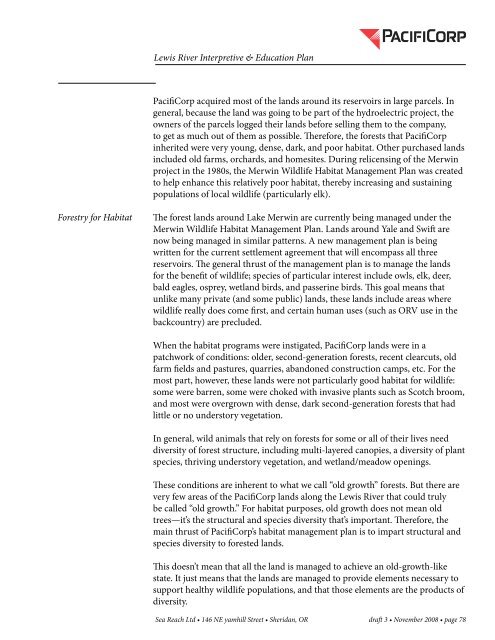The Lewis River Hydroelectric Projects - PacifiCorp
The Lewis River Hydroelectric Projects - PacifiCorp
The Lewis River Hydroelectric Projects - PacifiCorp
Create successful ePaper yourself
Turn your PDF publications into a flip-book with our unique Google optimized e-Paper software.
<strong>Lewis</strong> <strong>River</strong> Interpretive & Education Plan<br />
<strong>PacifiCorp</strong> acquired most of the lands around its reservoirs in large parcels. In<br />
general, because the land was going to be part of the hydroelectric project, the<br />
owners of the parcels logged their lands before selling them to the company,<br />
to get as much out of them as possible. <strong>The</strong>refore, the forests that <strong>PacifiCorp</strong><br />
inherited were very young, dense, dark, and poor habitat. Other purchased lands<br />
included old farms, orchards, and homesites. During relicensing of the Merwin<br />
project in the 1980s, the Merwin Wildlife Habitat Management Plan was created<br />
to help enhance this relatively poor habitat, thereby increasing and sustaining<br />
populations of local wildlife (particularly elk).<br />
Forestry for Habitat<br />
<strong>The</strong> forest lands around Lake Merwin are currently being managed under the<br />
Merwin Wildlife Habitat Management Plan. Lands around Yale and Swift are<br />
now being managed in similar patterns. A new management plan is being<br />
written for the current settlement agreement that will encompass all three<br />
reservoirs. <strong>The</strong> general thrust of the management plan is to manage the lands<br />
for the benefit of wildlife; species of particular interest include owls, elk, deer,<br />
bald eagles, osprey, wetland birds, and passerine birds. This goal means that<br />
unlike many private (and some public) lands, these lands include areas where<br />
wildlife really does come first, and certain human uses (such as ORV use in the<br />
backcountry) are precluded.<br />
When the habitat programs were instigated, <strong>PacifiCorp</strong> lands were in a<br />
patchwork of conditions: older, second-generation forests, recent clearcuts, old<br />
farm fields and pastures, quarries, abandoned construction camps, etc. For the<br />
most part, however, these lands were not particularly good habitat for wildlife:<br />
some were barren, some were choked with invasive plants such as Scotch broom,<br />
and most were overgrown with dense, dark second-generation forests that had<br />
little or no understory vegetation.<br />
In general, wild animals that rely on forests for some or all of their lives need<br />
diversity of forest structure, including multi-layered canopies, a diversity of plant<br />
species, thriving understory vegetation, and wetland/meadow openings.<br />
<strong>The</strong>se conditions are inherent to what we call “old growth” forests. But there are<br />
very few areas of the <strong>PacifiCorp</strong> lands along the <strong>Lewis</strong> <strong>River</strong> that could truly<br />
be called “old growth.” For habitat purposes, old growth does not mean old<br />
trees—it’s the structural and species diversity that’s important. <strong>The</strong>refore, the<br />
main thrust of <strong>PacifiCorp</strong>’s habitat management plan is to impart structural and<br />
species diversity to forested lands.<br />
This doesn’t mean that all the land is managed to achieve an old-growth-like<br />
state. It just means that the lands are managed to provide elements necessary to<br />
support healthy wildlife populations, and that those elements are the products of<br />
diversity.<br />
Sea Reach Ltd • 146 NE yamhill Street • Sheridan, OR draft 3 • November 2008 • page 78
















